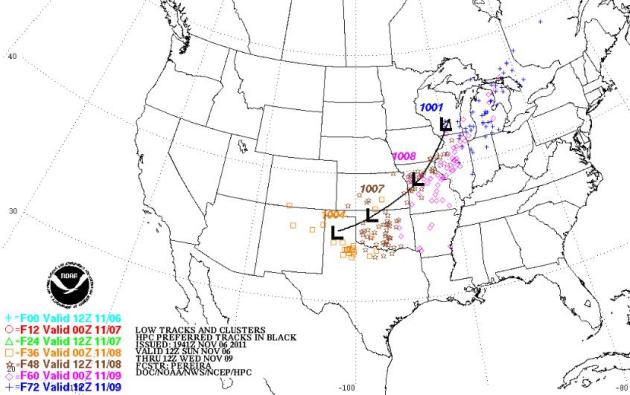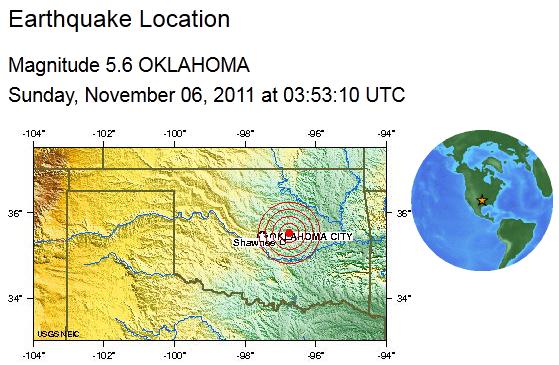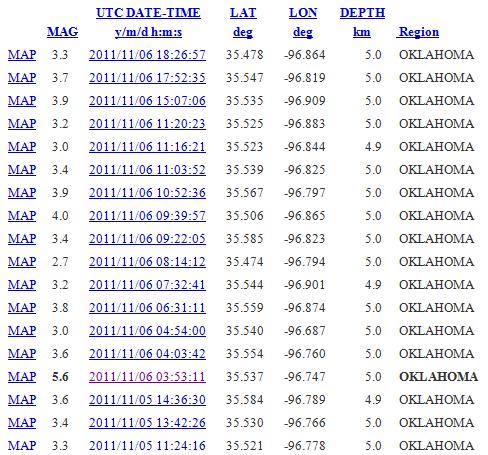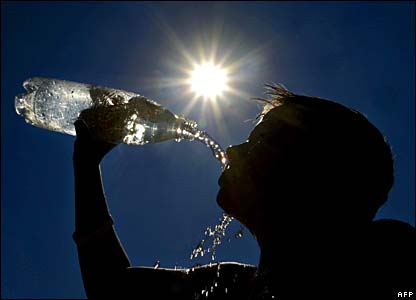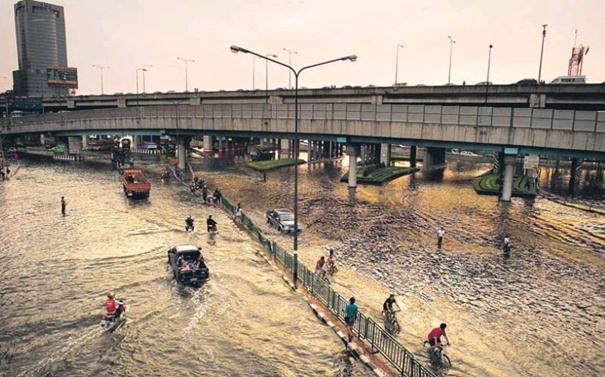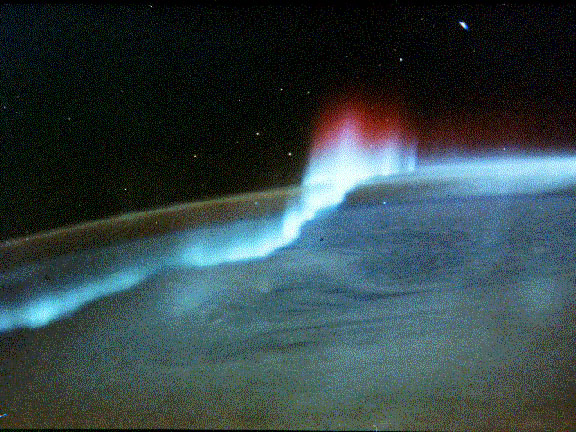 U.S. Anticipates Northern Lights Show This Week
U.S. Anticipates Northern Lights Show This Week. More solar flares are predicted, and that may increase the odds of seeing the Aurora Borealis this week. "
Anticipation is mounting that soon the world will be treated to an incredible light show with a sunspot bubbling with activity. Spaceweather.com reports that the unusually large sunspot unleashed at least five M-class solar flares since Saturday and has a “delta-class magnetic field that harbors energy for X-class flares.” Solar flares are ranked by NOAA’s Space Weather Prediction Center (SWPC) based on their x-ray energy output. M-class solar flares are the second strongest with X-class flares sitting at the top of the list. Even if a CME (coronal mass ejection) occurs, it may not head to Earth, as was the case last Thursday. With the sunspot situated on the sun’s outer edge (from Earth’s viewing point), the CME that was unleashed took aim on Mercury and Venus instead." (Aurora photo courtesy of NASA).
Midweek Storm. The next storm system is forecast to track from north Texas into Missouri, reaching Madison, Wisconsin by Wednesday morning, a cold rain mixing with wet snow (especially over Wisconsin). Map courtesy of NOAA.
Wednesday Slush over Wisconsin? The GFS model prints out as much as 2-6" snow near Oshkosh and Appleton, a slushy inch or two near the Quad Cities of Iowa. I think these amounts are a bit high, but the models have the right idea pushing the storm track farther east. A little slush can't be ruled out over the Minnesota Arrowhead, but right now odds do not favor any accumulation close to the Twin Cities metro area.
Evidence Of A Quake (On Doppler Radar?) Obviously - radar can't see the earth shaking (it's not quite that sensitive), but Doppler was able to track birds and insects taking flight after the 5.6 tremor began. Loop courtesy of the Oklahoma City office of the National Weather Service.
What Is Going On In Oklahoma? A 5.6 quake Saturday night, followed by at least 21 additional tremors in the 2.7 to 4.0 on the Richter scale in just the last 36 hours. More details from USGS
here.
Oklahoma 2011 Extremes. From the Norman office of the NWS: "
(Saturday night’s) 5.6 earthquake was the strongest ever recorded in Oklahoma. Even though it has nothing to do with weather, the new record is another on a long list of records set in Oklahoma this year."
Here’s a rundown of some of the statewide records for Oklahoma so far this year:
Most Snow in a 24 Hour Period: 27 inches Spavinaw, OK Feb 9-10, 2011
Coldest Temperature: -31 degrees Nowata, OK Feb 10, 2011
Largest Hailstone: 6.0 inches 2 miles north of Gotebo May 23, 2011
Highest Wind Speed highest official surface wind measurement (not radar-based) 150.8 mph El Reno May 24, 2011
Highest Summer Average Temperature: 86.8 degrees This was also the hottest average summer temperature in history for any state
Warmest August Average Temperature: 87.7 degrees
 National Hurricane Center Estimates More Than 240 Tropical Systems Were Missed Between 1900 to 2002
National Hurricane Center Estimates More Than 240 Tropical Systems Were Missed Between 1900 to 2002. Here's another eye-opening article from the
Boston Herald:
"With less than a month remaining in it, 17 named storms have emerged so far this hurricane season, ensuring this will be one of the most active years on record. Yet five of those storms were so weak that a few decades ago they likely would have been overlooked. Indeed, between 1900 and 2002, the National Hurricane Center estimates, it failed to identify more than 240 systems that might have been tropical storms but were mistakenly deemed too weak or went undetected because they were too far out in the ocean to be studied. Climatologists further guess that of those, 75 were hurricanes. Thanks to the satellite era, which came full force in the mid-1970s, forecasters are able to better estimate the strength of even the most distant systems. In the past 35 years, they have spotted dozens of storms that previously would have been discounted, 18 in the past five years alone." (image above courtesy of NASA).
Crippling October Snowstorm Prompts FEMA, MEMA, To Issue Reminder For Storm Preparedness. The timely reminder (and storm checklist) from
masslive.com: “
More severe weather systems will strike this area; it’s a matter of when, not if,” emergency agency officials said, with the message: “Get Ready Now.” Residents are being urged to assemble and keep disaster emergency preparedness kits close by and to be ready to evacuate at a moment’s notice if notified by local officials to leave their homes. Such kits should be kept in a portable container that residents can have take with them if they must evacuate their homes. "
An emergency preparedness kit should include:
• At least a three-day supply of food and bottled water for each family member;
• Manual can opener;
• Battery-powered radio and flashlights with extra batteries;
• First-aid kit with family members’ medications and prescription information;
• Hygiene and personal care items."
Opinion: Weathering Future Storms. So much of America's electrical grid is vulnerable to high winds (and falling branches on exposed, above-ground powerlines).
Northjersey.com has an Op-Ed about what we can do (in an increasingly stormy environment) to make the power grid more resilient: "
LAST WEEK’S freakish autumn snowstorm, the latest in a year that saw damaging blizzards, downpours and flooding, has sparked deepening concern that the region’s aging electricity infrastructure is straining under growing demand and becoming increasingly vulnerable to severe weather. The snowstorm alone left more than 600,000 New Jersey residents and businesses without power – 150,000 in Bergen and Passaic counties alone — and disrupted train service on NJTransit’s Morris and Essex and Montclair-Boonton lines all week. If storms such as Hurricane Irene and the Halloween Nor’easter are the new norm, as a growing number of climate scientists contend, can anything be done to protect and repair utility wires and poles and avoid sustained power outages?"
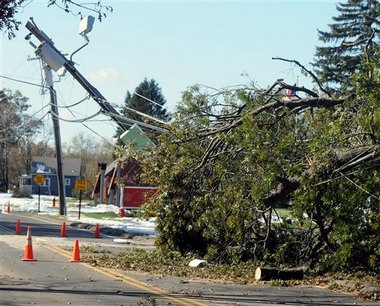 The Troubling Connecticut Power Failure
The Troubling Connecticut Power Failure. A foot or two of snow coming in January would be tough enough - but having that amount of heavy, wet snow falling in late October (with most leaves still on the trees) meant that thousands of tree limbs came down onto powerlines, causing the worst outage in the northeast power grid in recent memory. Here's more on the fallout from the October 29 storm from Reuters and
The New York Times: "
The moneyed folk inhabiting the Connecticut environs of the hedge fund town Greenwich wield plenty of power. But many of them have lately been powerless. For the second time in barely more than two months, a huge swath of the two million captive customers of Northeast Utilities, the power company that covers territory from the Constitution State up through western Massachusetts and into New Hampshire, have spent too many days without electricity. In an echo of the financial crisis, it turns out that better risk management and stronger regulation could have made the fallout much less bad. This raises serious questions about Northeast’s competence — and whether it should be allowed to complete a $4.7 billion takeover of a Massachusetts rival, Nstar." (photo above courtesy of masslive.com).
Flood Situation Worsens As Crisis Becomes Political. The story from
The Bangkok Post: "
The Bangkok Metropolitan Administration has given the government an ultimatum to start cooperating or it will ditch the existing plans it has to tackle the city's floods. Bangkok Governor Sukhumbhand Paribatra said yesterday the BMA would come up with a new flood management plan if the Flood Relief Operations Command (Froc) does not spell out by tomorrow how it will cooperate in tackling the floods. The BMA asked the Froc to provide water pumps and speed up flood drainage operations a week ago, but it had not received any response, the governor said. City Hall also asked the Froc to instruct the Royal Irrigation Department to open its 20 sluice gates in Nong Chok district to speed up water drainage to the Bang Pakong River in Chachoengsao province, but only nine of 20 sluice gates had been opened."
Secret To A Long, Healthy Life: Bike To The Store. The story from
NPR: "
What would you say to a cheap, easy way to stay slim, one that would help avoid serious illness and early death? How about if it made your neighbors healthier, too? It could be as simple as biking to the store. Researchers at the University of Wisconsin were wondering if getting people out of their cars just a wee bit would create measurable improvements in health. So they gathered up data sets on obesity, health effects of pollution, and air pollution caused by automobiles in 11 Midwestern cities, and did a mashup. They found that if the Midwesterners ran half of their short-distance errands by bike rather than by car, 1,100 deaths would be avoided each year, and $7 billion would be saved in reduced health-care costs. The trips were 2.5 miles one way; less than a 25-minute bike ride, the researchers figure."

"
Oh wow. Oh wow. Oh wow." Steve Jobs' last words before passing away, according to his sister, Mona Simpson, who was by his side. She recounts the story, and other memories of her brother, in this
powerful eulogy in the New York Times.


Climate Stories...
Shakespeare, Sunsets, Global Warming And You: How We Choose Experts On Matters That Matter. This is a rather profound post from
ABC News: "
Imagine you’re reading Shakespeare on an unseasonably warm evening while sitting on a dune looking west across the sea at sunset. Who really wrote that poetry, what caused that extra heat, and what’s really happening out on the horizon? You’ll need experts for all that. On sunset, scientists now have news this reporter finds it hard to keep a grip on. You watch the reddening sun move down toward the horizon until the bottom edge of the bright disc drops behind the rim of the sea. The still visible portion of the sun morphs into various shapes as it moves inexorably down until it’s just a tiny point of light. Then, as you can plainly see, it is suddenly gone as the sun travels even further below the horizon. Experts now tell us none of that is true. The sun isn’t moving down at all! Instead, the earth beneath you is rolling backwards so that its rounded bulk is slowly rising up between you and the sun."
Global Warming In Antarctica: Glaciers Accelerating, West Antarctic Ice Sheet Losing Mass. An update from
indymedia.org: "
Scientists have been studying the climate change impact on ice shelfs and glaciers for some time in Antarctica, and particularly around the Antarctic Peninsula where there is substantial warming occurring increasing ice shelf melt and the speed and discharge of glaciers. The most recent studies predict a faster retreat for the Thwaites Glacier and that warm ocean currents are already speeding the melting of the Pine Island Glacier and Ice Shelf and Getz Ice Shelf. A NASA Icebridge flight detected a major new rift in the Pine Island ice shelf on October 14 - the start of the calving of a massive iceberg. A recent paper in Nature Geoscience discusses the Stability of the West Antarctic ice sheet in a warming world and the likelihood of collapse that would raise sea level by more than three metres over the course of several centuries or less."
Climate Change, Beetle, May Doom Rugged Pine. How will climate change impact the North Woods of Minnesota and Wisconsin? Warmer winters, fewer nights colder than -40 F, allow beetles to survive yearround, increasing the threat to pine trees. The
Seattle Times has the story: "
SAWTOOTH RIDGE, Okanogan County — The bug lady scoots through stick-straight lodgepole and ponderosa, and marches uphill toward the gnarled trunk of a troubled species: the whitebark pine. The ghostly conifers found on chilly, wind-swept peaks like this may well be among the earliest victims of a warming climate. Even in the Northwest, rising temperatures at higher elevations have brought hundreds of thousands of whitebark pines in contact with a deadly predator — the mountain pine beetle — that is helping drive this odd tree toward extinction. Connie Mehmel, with the Okanogan-Wenatchee National Forest, is one of a handful of entomologists struggling to track the beetles' destructive path. Mountain pine beetles are probably best-known here as the trunk-girdling devils that have reddened and deadened millions of acres of lodgepole, exposing the Northwest to a greater potential for cataclysmic wildfires. But the evolutionary history of lodgepole pine and beetles is so intertwined that those forests in many places are expected to grow back. Whitebark pines may not."
Climate Change Effects The Seasons: Autumn Doesn't Know If It's Coming Or Going. The U.K.
Telegraph has the story: "
And why?” my wife Lucy demanded yesterday as she peeled off her gardening gloves, “are my clematis and roses in full bloom on November 1, and why am I still being bitten by gnats and midges?” Standing in shirt sleeves and muddy-kneed cords, brandishing a pair of secateurs, she sounded cross. “I’m supposed to be putting the garden to bed for the winter, not admiring summer flowers and swatting bugs.” The truth is, I don’t know. I’m not convinced anyone knows exactly how climate change is affecting our planet. Nor does anyone know how quickly it’s happening or whether it will last. “Oh, it’s just cyclical,” people say. But perhaps it’s terminal. Maybe the planet’s hitting back after two and a half centuries of industrial man’s abuse and the ravages of our carefree explosion to seven billion mouths, announced last week. What if these signals are a sort of Gaia comeuppance? Perhaps the plants and insects know better than us – they’re certainly more sensitive and less devious – and maybe we should heed their omens."
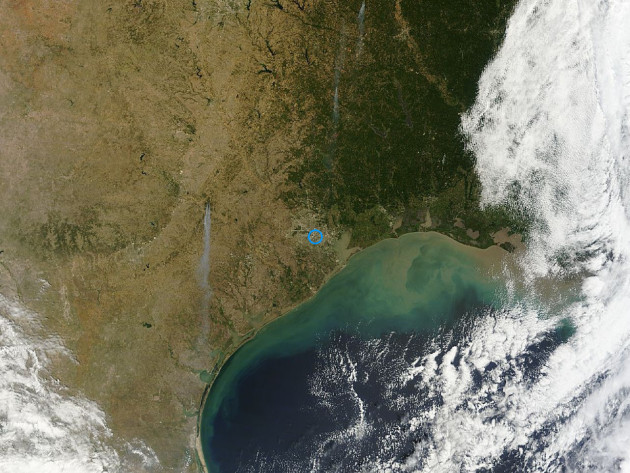 Real Climate Change: From Green To Brown
Real Climate Change: From Green To Brown. Here's an Op-Ed from Corpus Christi's
caller.com: "
For some Americans, climate change is a figment of the overheated imagination of liberal-leaning, pickup truck-hating, CNN-watching, New York Times-reading, Obama- voting, granola-eating scientists. These Americans aren't convinced that there is anything to worry about. Anytime a snowstorm pops up, they ask, where's that global warming? I'm no scientist. In fact, my grasp of the theory of the wheel is a little unsure. But I figure that if a lot of scientists are convinced that there is global warming, and that human activities are contributing to that warming, then the possibility that there is something to the assertion has to be considered. That the Earth is, in fact, warmer is now indisputable fact. Last year tied for the warmest year on record, adding to the recent number of years that rate at or near the top of warm years. Most of the warming has occurred since the 1970s, leading to the not surprising conclusion that human activity has a lot to do with the heating trend. But climate change is one of those issues, like whether Obama's birth certificate is real or whether Al Gore won Florida in 2000, that has more to do with politics than science. That's likely why the TCEQ is likely to shelve a recent scientific report on the health of Galveston Bay which the agency commissioned." (Satellite image courtesy of NASA).
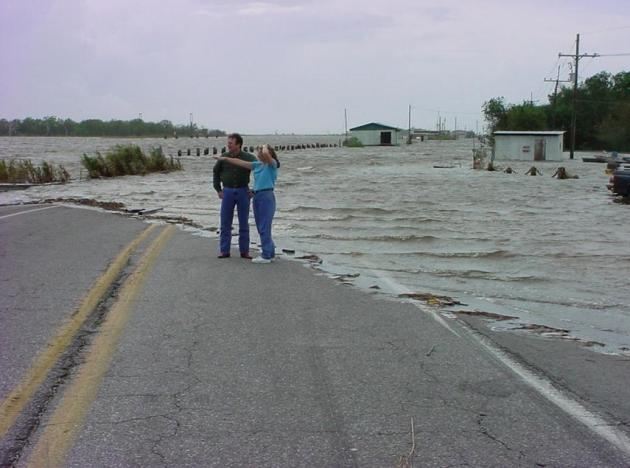 Climate Change Endangering Florida
Climate Change Endangering Florida.
Theledger.com has an Op-Ed: "
I recently returned from a national environmental journalism conference in Miami. It was no accident that climate change and sea level rise were prominent on the agenda. If things continue as predicted, the bottom floors of the hotel where we were meeting would be part of Biscayne Bay — well offshore in Biscayne Bay — by the turn of the century. And even the parts of Dade County that aren't underwater will be uninhabitable because the rising sea level will have made much of the Biscayne Aquifer, the shallow aquifer that supplies drinking water in this part of Florida, too salty to drink. That will force regional water managers to move wells farther inland at great expense to supply water to whatever areas in the region are still habitable. Add to that the fact that substantial portions of South Florida that aren't covered by the advancing sea will be underwater anyway. That's because the canal system that for decades drained subtropical rainfall to the sea will be relatively useless."

